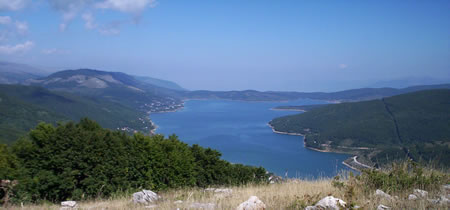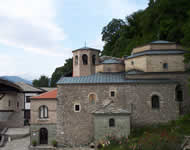
Mavrovo National Park and tourist resort
Just 10 km away from Mavrovo, the Mavrovo National Park covers an area of 73,088 hectares and is the largest of the three national parks in Macedonia. The Mavrovo National Park abounds in flora with over 1,000 plant species, 38 of which are trees, 35 bush shrubs, and 60 are endemic, relict, or rare species. The fauna in the Mavrovo National Park is rather diverse. It consists of 140 bird species, among which the grey haw, imperial eagle, golden eagle, forest owl, marsh harrier, etc. The most famous man-made lake in Macedonia is definitely Lake Mavrovo. This 10km-long and 3km-wide lake covers an area of 13.7 sq km and is 48m deep. The beautiful landscape in this area will enchant those who enjoy walking, cycling, and hiking in the summer months, while for those who like skiing Mavrovo is the most famous winter resort. The Mavrovo Ski Centre has three chair lifts and 11 ski lifts. The length of the chair lifts is 4,800m with a capacity of 1,900 persons per hour. With these lifts, skiing is possible from 1,255m to 1,860m above sea level. There are tracks for beginners, advanced, and top competitors in the alpine and Nordic categories. The exquisite natural beauty makes Mavrovo a popular weekend resort with over 1,000 weekend houses and hotels, offering accommodation for tourists all year round.
  Radika River Canyon Radika River Canyon
If you have ever read the descriptions of the magnificent landscapes and scenery in the wonderful tales by the Grimm Brothers, then you could imagine the beauty of the Radika River Canyon. The 40km-long Radika Canyon is certainly one of the most picturesque and steepest canyons in Europe. In its cold and clear waters lives the famous river trout, which challenges fishermen from all over the Balkans.
  St. John the Baptist Bigorski Monastery St. John the Baptist Bigorski Monastery
The St. John the Baptist Monastery rises among the beautiful slopes of Mount Bistra, in the valley of the river Radika. It is located on the road between Gostivar and Debar and according to historical sources the monastery was established in either 1020 or 1021 A.D. The actual buildings that can be seen today originate from the 18th and the beginning of the 19th centuries. Dominating the whole complex is the monastery chapel, dedicated to St. John Preteca (the one who announces) and was built in 1800.The fresco paintings in the church were done by several master fresco painters (Mihail and Danail, Vasilie Ginoski, and master painter from Tresonce Dico Zograf) in different periods. The iconostasis represents a masterpiece of woodcarving performed by the woodcarvers of the Mijak region. On the limited space, the masters have depicted scenes from both the Old and the New Testaments. In all of the scenes they have presented more than 500 human images, 200 various animals, while the decorations that exploit motifs are most impressive. Most of the complex is taken up by the monastery lodging (konak), equipped with a kitchen.
back |